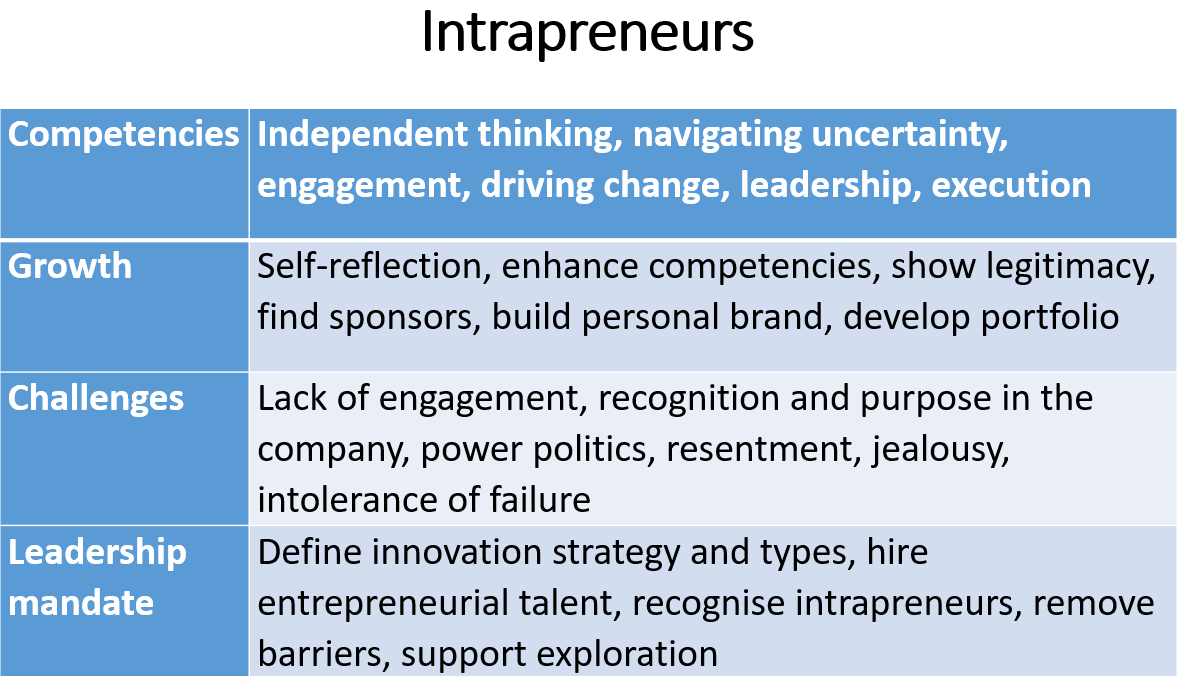Launched in 2012, YourStory's Book Review section features over 330 titles on creativity, innovation, knowledge work, and digital transformation. See also our related columns The Turning Point, Techie Tuesdays, and Storybites.
The business need for intrapreneurship, qualities of intrapreneurs, and enabling factors for business success are covered in the insightful book, Intrapreneurs: Who, What, How and Why, by Susan Foley.
Intrapreneurs are corporate entrepreneurs or internal entrepreneurs; they are regarded as mavericks, pioneers, builders, innovation champions, and change agents. They don’t sit on the sidelines; they create new mental models and move themselves ahead while bringing change and innovation to their company.
The book provides a range of perspectives on the traits of intrapreneurs, challenges they face, and engagement strategies for leadership. Some case studies, figures, and a reference section would have been welcome additions to the material, and there is quite a bit of repetition and several typos as well.
Susan Foley is Managing Partner of business consultancy Corporate Entrepreneurs LLC. The book draws on her own experience as an intrapreneur. Her other books are Entrepreneurs Inside and Acceleration: Changing the Speed of Growth. She has taught at Babson College and Suffolk University.
Here are my seven clusters of takeaways from this 260-page book, summarised as well in the table below. See also my reviews of the related books, Gorillas Can Dance, Multipliers, Moonshot Effect, Rebel Talent, The Invincible Company, Dual Transformation, Innovator's Path, The Creative Mind, and Intrinsic.

I. Context
“Intrapreneurs have a different mindset, thinking process, decision making and propensity to act,” Susan observes.
Many intrapreneurs have side projects, which may be inside or outside the company. Serial intrapreneurs execute a range of projects, irrespective of what their role is at those times.
Intrapreneurs are different from entrepreneurs in their ability to understand the constraints and strengths of the corporate world, and navigate through to the creative purpose. They also have the financial and career cushion of the corporate environment, with less risk.
Many companies have set up accelerators to engage with external entrepreneurs and startups, but they need to improve their own internal support for intrapreneurs. They need to exploit the core business while also exploring new businesses.
“Organisations must cultivate the entrepreneurial mindset while they maintain the balance between the core business and growth business,” Susan emphasises. Juggling this requires finesse, competence, and stamina.

II. Foundations
“Intrapreneurship is a process used to develop new businesses, products, services or processes inside of an existing organisation to create value and generate new revenue growth through entrepreneurial thought and action,” Susan defines.
Intrapreneurs are creators, doers, and implementers. They are good at idea generation, communication, and task execution. They take calculated risks, balance intuition and data, focus on the future, and are confident and persistent.
“Unlike more traditional employees, intrapreneurs are willing to step up, speak up, and stick out even in uncertain times,” Susan observes. They love the exhilaration though it may be a roller-coaster journey. They are restless and need to be consistently challenged to stay ahead.
Intrapreneurs believe strongly in what they are doing, which may even turn into a cause. “That’s why most intrapreneurs are loyal to their project first, then the organisation,” she adds.
“They are not afraid to fail. They are more concerned if they don’t try,” Susan explains. “They see failure as a step to success.”
“If you aren’t failing, you aren’t learning and growing. The only way to get better is to experience both success and failure,” she suggests.

III. Qualities
Susan defines six key competencies of intrapreneurs: independent thinking, navigating uncertainty, engagement, change, leadership, and execution.
1. Independent thinking
“Intrapreneurs are willing to explore the unknown,” Susan describes. They are whole-brain and integrative thinkers. They embrace complexity, and can spot patterns and linkages.
2. Navigating uncertainty
“Intrapreneurs embrace the unknown, they see it as a field of possibilities,” Susan observes. They can deal with uncertainty and ambiguity via flexibility and experimentation.
Their plans can balance short-term demands and long-term needs. Intrapreneurs are collaborative but can also be competitive.
3. Engagement
“Intrapreneurs are highly engaged in their work. They love the excitement of challenge,” Susan describes. They want to stretch and grow. They are self-starters and want to find opportunities and solve challenges.
4. Change
“Intrapreneurs not only drive change, they break down resistance to change,” Susan writes. “They take the lead, they make change happen.”
5. Leadership
Though intrapreneurs may not always be inventors, they are team builders and business architects. They collaborate, network, and build relationships.
6. Execution
Execution is based on vision and the ability to deliver. Intrapreneurs executive iteratively and flexibly, and are good negotiators. They can deal with pressure and are high on closure, Susan describes.

IV. Organisational impacts
Intrapreneurs help generate new business growth. They facilitate and accelerate change. Supporting them helps a company attract and retain the best and brightest talent, Susan suggests.
“Intrapreneurship helps employees stretch and grow while keeping them engaged,” she adds.
Companies such as Google, Apple, Intel, Virgin, 3M, and Lockheed-Martin have benefited from intrapreneurs. They help create new products and processes, and rebrand organisations to be more innovative.
V. Challenges
Unfortunately, many companies have short-term financial pressures and do not invest in long-term intrapreneurship support; a balanced approach is called for.
If intrapreneurs are not sufficiently engaged in their companies, they may leave to start up their own ventures or become independent consultants and gig workers, Susan cautions. Others may stay but just stick to the core business.
Millennials, in particular, are looking for more purpose, social consciousness, and creativity in their workplaces. Intrapreneurship programmes can help reinvigorate, re-energise, and redesign work environments, Susan affirms.
“Depending on how your organisation looks upon failure, it can be career-limiting or career-enhancing,” she cautions.
Other barriers from colleagues can be resentment, jealousy, and power politics due to loss of control or unwillingness to change. She advises intrapreneurs to reflect on how their capabilities “complement, contrast or conflict” with others in the company.
“The challenge for intrapreneurs is knowing how far they can push the boundaries of the organisation,” Susan cautions.
Successful intrapreneurs may be recognised internally, but stories about them do not seem to be publicised outside, she laments. More academic and industry research in this space is needed.

VI. Leadership mandate
Organisations must decide how much to invest in the different types of innovation: extensions, enhancements, and transformations. Each calls for different approaches, investments, and cultures.
“Intrapreneurship must be customised to the unique and diverse culture and operating environment of each organisation,” Susan advises. Some other employees may already be intrapreneurial, it is up to the management to recognise and empower them.
Leaders need to factor in the policy to tolerate and learn from failure as part of experimentation. Instead of focusing only on operational efficiency and risk management, they need to become more proactive and innovative.
“Proactively recruit entrepreneurially-inclined individuals,” Susan advises.
It is important to give them freedom and flexibility to experiment, let them tackle pressing challenges, provide mentors and sounding boards, and remove organisational hurdles.
Traditional leaders who want to become intrapreneurial leaders need to themselves build these kinds of competencies and skills as well.

VII. The road ahead
Intrapreneurs need to self-reflect on their own competencies and achievements and enhance their skills and capabilities. Susan advises them to build a portfolio of intrapreneurial experiences, and take on bigger and more challenging opportunities.
“True intrapreneurs love the highs, the lows, the long hours, the heated debates, and the pressure to deliver something new,” she explains. They want to shape the future and make a difference.
To succeed in the long run, intrapreneurs must earn the right to be one. They should show legitimacy through skills, networks, and projects.
Susan advises them to bring on board a range of supportive stakeholders: CEO, sponsor, teams, and customers. Intrapreneurs should question decisions made at the top, but co-create with customers and partners as well.
“Being an intrapreneur is not a destination, it’s a journey,” Susan describes. “Create a personal brand, develop presence, and demonstrate credibility,” she advises.
This involves continuous improvement through learning about oneself and the company, and pushing the boundaries. Mindset, decisiveness, and action are the outcomes. Intrapreneurs need to assess how they are growing in terms of creative scope, priorities, and influences.
Intrapreneurship is a journey of the head and heart, intellect and action, self and community, Susan concludes.
In sum, in times of increasing change and uncertainty, intrapreneurship can help organisations deal with complexity, take calculated risks, create new markets, and retain creative talent.
YourStory has also published the pocketbook ‘Proverbs and Quotes for Entrepreneurs: A World of Inspiration for Startups’ as a creative and motivational guide for innovators (downloadable as apps here: Apple, Android).
Edited by Saheli Sen Gupta






